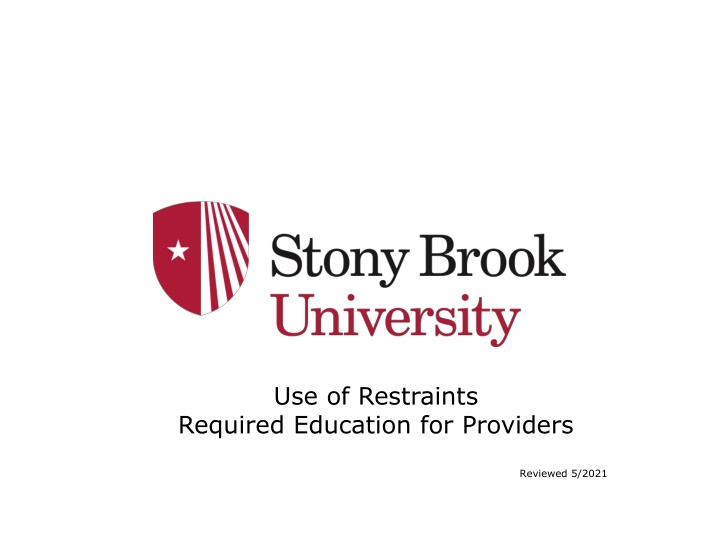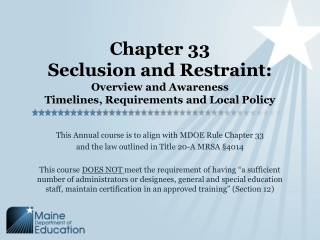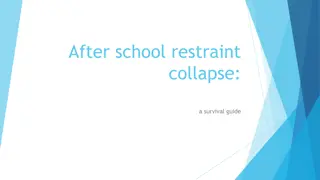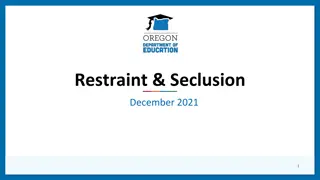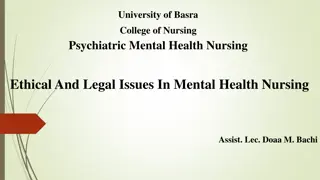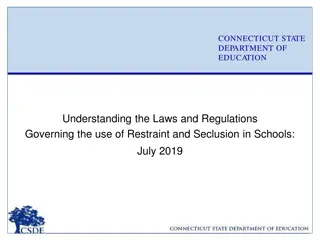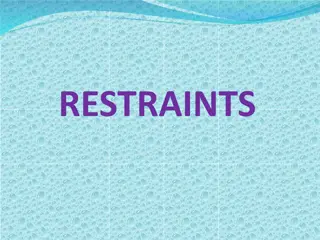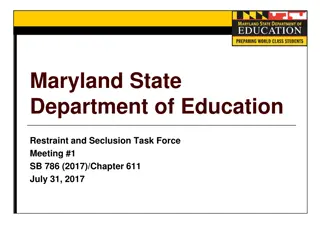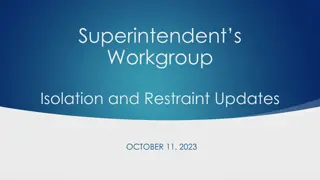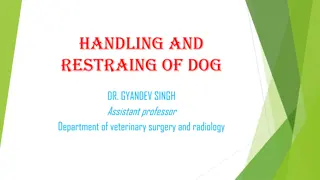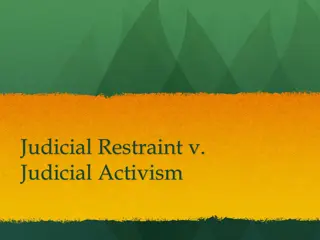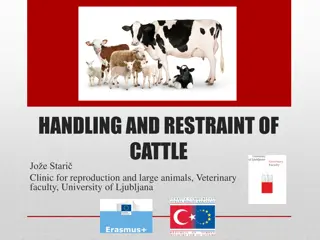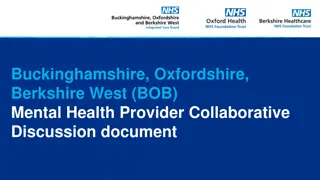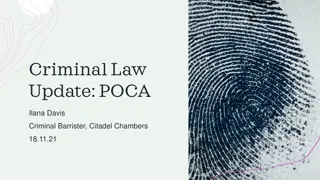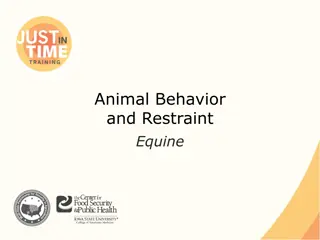Restraint and Seclusion: Provider Education and Guidelines
This educational material reviews the use of restraints and seclusion in healthcare settings, emphasizing the identification of triggers, nonphysical intervention skills, and patient assessment for least restrictive interventions. It defines restraint and seclusion, lists associated risks, and highlights best practices and regulatory standards. Detailed information on restraint types, duration limits, and seclusion use is provided to ensure safe and effective implementation. Providers are trained on how to make informed decisions based on patient behavior while prioritizing patient safety and well-being.
Download Presentation

Please find below an Image/Link to download the presentation.
The content on the website is provided AS IS for your information and personal use only. It may not be sold, licensed, or shared on other websites without obtaining consent from the author.If you encounter any issues during the download, it is possible that the publisher has removed the file from their server.
You are allowed to download the files provided on this website for personal or commercial use, subject to the condition that they are used lawfully. All files are the property of their respective owners.
The content on the website is provided AS IS for your information and personal use only. It may not be sold, licensed, or shared on other websites without obtaining consent from the author.
E N D
Presentation Transcript
Use of Restraints Required Education for Providers Reviewed 5/2021
Course Goals After completing this course, you should be able to: Define restraint and seclusion List the risks of restraint and seclusion Recognize best practices and regulatory standards for the use of restraint and seclusion SBUH restraint policy is Administrative manual: PC0008 Restraint and Seclusion
Providers must be trained and competent in the following: 1. How to identify behaviors, events, and situations that may trigger circumstances that require the use of restraint or seclusion 2. How to use nonphysical intervention skills 3. How to use an assessment of the patient s status or condition to choose the least restrictive intervention
Restraint is any method for limiting: Patient movement Patient activity A patient s normal ability to reach parts of his or her own body Seclusion is the confinement of a patient to an area that they are prevented from leaving. The decision to use restraint or seclusion is based on the patient s behavior. Each patient must be assessed to determine if restraint or seclusion is needed. No patient may ever be restrained in any way, in a prone position, as the risk of asphyxiation is high.
Definitions of Restraint Types Violent/Self-Destructive Patient Restraint Use: The restriction of patient movement in response to severely aggressive, violent, destructive, self-destructive, or suicidal behaviors that place the patient or others in imminent danger. The duration of time for adults 18 years and above may not exceed 2 hours, for children 10-17 years may not exceed 1 hour and for children 9 years and younger 30 minutes at which time a new restraint order is entered or discontinued. Non-Violent Patient Restraint Use: Restraint used to restrict a patient s movement as to assist with the provision of medical or surgical care. (i.e. preventing removal of lines and/or tubes). Patient immobilization that is a normal component of a procedure (e.g. MRI, surgery, etc.) is not considered restraint. Restraint orders must be either reordered or discontinued daily.
Use of Seclusion: Seclusion: The involuntary confinement of a patient alone in a room, under continuous observation or area from which the patient is physically prevented from leaving. Seclusion may be used only for the management of violent or self-destructive behavior that jeopardized the immediate safety of the patient, a staff member or others. Confinement on a locked unit, where the patient is with others, does not constitute seclusion.
Hospital Approved Physical Restraints: 1. Vest 2. Wrist or wrist and ankle either soft or polyvinyl or neoprene 3. Hand mitt or mitten (only a restraint if tied down) 4. Wrist, ankle and soft chest band (not to be used alone) used simultaneously is limited to use in psychiatric units 5. Side rails of bed (when all four side rails are up and the intention is to restrict the patient to bed) 6. Enclosure bed (only considered a restraint if all sides are zipped) NOTE: May be ordered in combination with Vest when OOB to chair. 7. Physical holds: Holding a patient in a manner that restricts the patient s movement against the patient s will.
Use of restraint has risks. Therefore, all healthcare facilities should work toward reducing or eliminating use of restraint. Facilities should: Intervene early to avoid later need for restraint Find alternatives to restraint Restraint should be used only when: Less restrictive interventions are ineffective Clinically justified to promote healing Warranted by violent patient behavior that threatens the physical safety of the patient, staff, or others Restraint and seclusion should NEVER be used to: Discipline a patient Make patient care tasks more convenient for staff Make a patient do something against his/her will Retaliate against a patient The patient s rights and safety must be protected during restraint or seclusion.
NON-VIOLENT RESTRAINTS Restraint or seclusion for non-violent patients must be ordered by a Physician or LIP : Orders must be issued on a case-by-case basis. Orders are time-limited. PRN (as needed) orders are NEVER acceptable. Every day, the physician or LIP who is primarily responsible for the patient must see and re-evaluate the patient before writing a new order. The need for the restraint is documented in the note.
NON-VIOLENT RESTRAINTS Patients who have been placed in restraints by an RN emergently for non-violent reasons must be have an order placed immediately (not to exceed 5 minutes) and be evaluated within one hour and re-evaluated in person by the provider primarily responsible for his or her care every day. Patient must be on One to One Observation as well as restraint until the LIP evaluation (within one hour) is completed. The evaluation AND documentation must include: The patient s immediate situation The patient s reaction to the intervention The patient s medical and behavioral condition The need to continue or terminate the restraint or seclusion Patients must also be monitored during restraint or seclusion by qualified and trained unit staff according to hospital policy.
VIOLENT/SELF-DESTRUCTIVE RESTRAINTS Restraint or seclusion for Violent/Self-destructive patients may be ordered by a Physician/LIP on a Med/Surg Unit and ONLY by a Physician in a Psychiatric Unit: Orders must be issued on a case-by-case basis. Patient is on 1:1 observation as long as they are in a violent restraint Orders are time limited and restricted to a specific duration based on patient age: 2 hours for ages 18 and up 1 hour ages 10-17 30 minutes age 9 and younger PRN (as needed) orders are NEVER acceptable. Every 24 hours or less, the physician who is primarily responsible for the patient must see (face to face) the patient before renewing any more orders and document their evaluation. i.e. after initial order and face to face evaluation, renewals may be done but only for 24 hours before re-evaluation the patient. Orders cannot be renewed on psychiatric services but can renewed, if needed, on other services. See slide # 13 &14 for additional requirements for patients in a Psychiatric Unit in Violent/Self-Destructive Restraints and/or Seclusion
Restraint and seclusion must be documented fully in the patient s medical record. Documentation i.e. progress note should include: a. Actions/behaviors or conditions that indicated the initial and/or continued use of restraint. b. Consideration or failure of nonphysical interventions/alternatives. c. Restraint orders/time of initiation. d. Patient monitoring/assessment/reassessment. e. Significant changes in the patient s condition.
POTENTIAL PHYSICAL AND PSYCHOLOGICAL ISSUES RELATED TO USE OF RESTRAINTS Positional asphyxiation- During holding of a patient it is important to have another person monitor the patient for signs of respiratory distress, i.e. inability to breath while being held. Release if patient has respiratory distress. Hanging in a restraint- if a patient is witnessed hanging by their neck in a restraint, it is to be immediately removed (cut off if necessary). Lower patient to the floor, get help and begin CPR as needed. Circulatory compromise- if a restrained limb is blue, or cold, or painful to patient, then immediately release the restraint and call for help. Psychological distress r/t restraint- if patient communicates feelings of helplessness or hopelessness while in restraint, release the patient from the restraint if appropriate and consider a consult to pyschiatry. Bleeding- if a patient is found to be bleeding, release restraint, apply pressure to the site and call for help. Choking- if a patient is found to be choking on food/fluids or any foreign body i.e. medications release restraints, place the head of the bed up and administer Heimlich maneuver if necessary. Call for assistance. If a patient is found unconscious, release restraints, call for help, open airway, and begin CPR if necessary. Universal Precautions apply to all patient contacts
POWERCHART ORDER ENTRY This button not constitute a note. Non-Violent Restraint order- all fields are required. If you have already seen the patient, choose yes. A screen will pop up, click continue and the Face to Face Note will appear. Complete this and your face to face note is done. If you click no, you need to add THIS specific note when you do see the patient. Restraint orders are final once signed and can no longer be modified. Renewals need all required fields.
This is the required face to face form that pops up when you click yes and choose continue from the order for both Non-Violent and Violent Self Destructive Restraint orders.
POWERCHART ORDER ENTRY This button not constitute a note. Violent-Self Destructive Restraint order- all fields are required. Please make sure if you have If you have already seen the patient, choose yes. A screen will pop up, click continue and the Face to Face Note will appear. Complete this and your face to face note is done. If you click no, you need to add THIS specific note when you do see the patient. UNLESS the patient is on a behavioral health unit (CPEP, 12 N or 10N). Restraint orders are final once signed and can no longer be modified. Renewals need all required fields. Behavioral Health units must always have a new (initiation order for all episodes). This is the end of the presentation for MD/LIP s that do not work in psychiatric units.
ADDITIONAL REQUIREMENTS FOR RESTRAINTS ON A PSYCHIATRIC UNIT More ordering requirements on a Psychiatric Unit: Physician face to face must occur within 20 minutes. Under the very rare circumstance when this is impossible (e.g., physician is addressing life threatening situation with another patient), the RN is to place a note in the chart explaining the circumstance and the physician must also document the reason for the delay at the time the evaluation is conducted. Renewals are not used on psychiatric units. Once an order is about to expire the patient should be afforded the opportunity for release, if imminent danger is still present, a new initial order is required as is all documentation and another face to face evaluation by the ordering physician.
ADDITIONAL REQUIREMENTS FOR RESTRAINTS ON A PSYCHIATRIC UNIT Debriefing on a Psychiatric Unit: The patient is informed of the behavioral criteria for discontinuation of the restraint. Debriefings occur as follows: 1. Patient Debriefing Occurs as soon as possible after the episode with the patient for the purpose of assessing the patient s needs and the patient s response to the event. What might have been prevented and how to prevent future episodes. 2. Post-acute Event Analysis Staff Debriefing Occurs as soon as possible after the episode with involved staff for the purpose of assessing the patient and staff members immediate needs. What might have been prevented and how to prevent future episodes. 3. Formal debriefing with leadership Occurs as soon as possible after the episode (within 24 hours of episode or the next business day) to delineate details of the episode, elicit participants feelings regarding the events, and identify any operational and/or training issues that may require attention.
